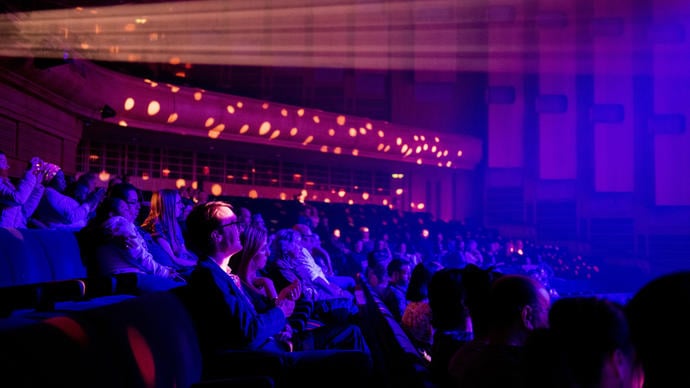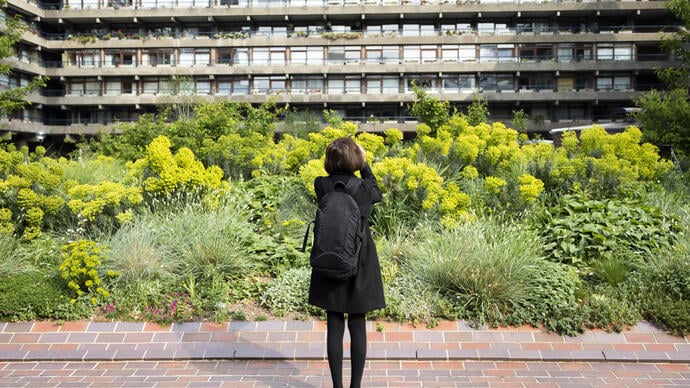Beatrice Rana

Beatrice Rana brings characteristic imaginative flair to her recital tonight, with a programme that takes us from Liszt’s great sonata into the early 20th century and the contrasting sound worlds of Scriabin, Debussy and Castelnuovo-Tedesco.
For her Barbican recital debut, Italian pianist Beatrice Rana presents a programme of dazzling and demanding music that offers a kaleidoscopic range of colours and styles.
Two fantasies, quite different in scale though sharing the same key, bookend this contrasting programme: Scriabin’s Fantasie in B minor, Op 28 and Liszt’s B minor Sonata – a fantasy in all but name. Between these two works, Beatrice Rana whisks us away to Romantic landscapes, moonlit evenings and enchanted islands in deeply evocative and atmospheric music by Castelnuovo-Tedesco and Debussy.
Scriabin’s Fantasie captures the essence of the composer’s melding of late- Romantic and early-Impressionistic styles. Written in 1900, this one-movement work explores new harmonic and expressive possibilities, and spans a spectrum of emotions, from introspective melancholy to passionate fervour. A lyrical opening melody serves as the foundation for the piece. As it unfolds, chromatic harmonies and intricate key changes create a sense of continuous transformation and uncertainty of direction, contributing to the Fantasie’s dreamlike quality, drawing the listener into a world in which conventional tonal boundaries are stretched and redefined. Virtuosic elements – sparkling runs and arpeggios – are interwoven with moments of contemplative introspection, offering the listener a heightened emotional experience.
From the expressive contrasts of Scriabin, we are transported to the serene landscapes of Tuscany in Mario Castelnuovo-Tedesco’s Cipressi (1920), an evocative, rarely performed piece whose delicate textures and melodies suggest the graceful sway of cypress trees, in this instance those at the Villa Forti in Usigliano, where the composer spent many of his summers.
The piece opens with a tranquil melody, rich in Italianate lyricism yet with hints of Debussy and Liszt, tinged with a Spanish poignancy in its haunting, folk-like melody. It gradually builds in intensity, painting a vivid musical picture of the Tuscan landscape’s changing colours and scents.
Debussy takes us to an even more exotic setting in his La terrasse des audiences du clair de lune, from Book 2 of his Préludes, the inspiration for which was an article in the newspaper Le temps in December 1912; this described the durbar at which King George V was crowned Emperor of India. Its opening evokes the first notes of Clair de lune (from Debussy’s Suite bergamasque); what follows is an enchantingly atmospheric nocturne replete with sensuous harmonies and shimmering textures.
The western wind then rolls in with Ce qu’a vu le vent d’ouest (What the West Wind Saw), in its wake revealing secrets and untold stories. The title comes from a story by Hans Christian Andersen, but the inspiration could equally be Shelley’s Ode to the West Wind, which Debussy had read in translation. The wind’s gusty, swirling fury is dramatically portrayed with powerful chords in the lower register of the piano, sweeping arpeggios, bold harmonies and surprisingly dense textures. The piece culminates in a thunderous climax, in which the full force of the wind is unleashed, before dying back into a haunting, lingering quietude.
A painting by Watteau, L’embarquement pour Cythère, was the inspiration for Debussy’s L’isle joyeuse (1904), although another isle, the island of Jersey, is also implicated in the title. It was here that Debussy revised the piece while on holiday with Emma Bardac, who became his second wife. Whatever the geographical setting, Debussy invites us to an idyllic island, one in which the sun shines brightly and laughter fills the air. The piece is characterised by its virtuoso, playful piano writing, with cascading arpeggios and brilliant trills that evoke sparkling waves and joyous festivities and surely owe a debt to Liszt.
Beatrice Rana turns to Liszt himself for the final piece: his B minor Piano Sonata, which was written between 1842 and 1853 and is regarded by many as his ultimate masterpiece. It now holds an unassailable place alongside other greats in the pantheon of piano repertoire, but over the decades it has provoked extreme reactions, from admiration to suspicion and envy. The critic Eduard Hanslick declared, ‘Anyone who has heard this and finds it beautiful is beyond help’, while Wagner heaped praise upon it; more recently, Alfred Brendel has called it ‘the most original, powerful and intelligent sonata composed after Beethoven and Schubert’.
With its innovative single-movement structure, it is a monumental masterpiece that pushes the boundaries of form and expression. Its structure references both the Classical sonata form as conceived by Haydn and Mozart and continued by Beethoven and Schubert, and the looser term ‘sonata’, meaning an instrumental work usually in four movements. Liszt combines these meanings to create a single movement in which the sections of the work are linked via distinctive themes or motifs, as in a fantasy.
Thematic transformation, intricate counterpoint, recurring motifs and a rich harmonic palette create a narrative that unfolds like a dramatic journey, from the mysterious and brooding opening through an energetic operatic-like dialogue to a deeply expressive slow movement which forms the centrepiece of the sonata. The recapitulation follows, its driving, dissonant fugato building to a grand climax. The final moments reprise the mystery of the opening and the work ends in a mood of quiet optimism in the major key.
© Frances Wilson
Details
Programme and performers
Alexander Scriabin Fantasie in B minor
Mario Castelnuovo-Tedesco Cipressi
Claude Debussy Prélude Book 2 No 7, La terrasse des audiences du clair de lune
Prélude Book 1 No 7, Ce qu’a vu le vent d’ouest
L’isle joyeuse
Franz Liszt Piano Sonata in B minor
Beatrice Rana piano
Beatrice Rana
Beatrice Rana has rapidly gained admiration from conductors, critics and audiences internationally.
She performs at the world’s most esteemed concert halls, including the Berlin Philharmonie, Amsterdam Concertgebouw, Carnegie Hall and Lincoln Center, New York, Wigmore Hall, Royal Albert Hall and Royal Festival Hall here in London, Philharmonie de Paris, Théâtre des Champs-Élysées, Vienna’s Konzerthaus and Musikverein, KKL Lucerne, Cologne Philharmonie, Munich’s Gasteig, Prinzregententheater and Herkulessaal, Frankfurt’s Alte Oper, Hamburg’s Elbphilharmonie and Laeiszhalle, Liederhalle Stuttgart, Zurich Tonhalle and Philharmonie de Luxembourg.
She collaborates with conductors such as Yannick Nézet-Séguin, Jaap van Zweden, Sir Antonio Pappano, Manfred Honeck, Klaus Mäkelä, Gianandrea Noseda, Fabio Luisi, Riccardo Chailly, Paavo Järvi, Valery Gergiev, Yuri Temirkanov, Vladimir Jurowski, Gustavo Gimeno, Lahav Shani, Jakub Hrůša, Dima Slobodeniouk, James Gaffigan, Mirga Gražinytė-Tyla, Gustavo Gimeno, Susanna Mälkki and Zubin Mehta.
She has appeared as a soloist with many leading orchestras, including the Royal Concertgebouw Orchestra, the Helsinki, London, Los Angeles, Luxembourg, Munich, New York, Royal Liverpool, Royal Stockholm, St Petersburg and Seoul Philharmonic orchestras, the Antwerp, Bavarian Radio, Boston, BBC, Chicago, City of Birmingham, Dallas, Danish National, Detroit, London, Lucerne, Melbourne, NHK, Pittsburgh, San Francisco, Toronto and Vienna Symphony orchestras, Chamber Orchestra of Europe, Orchestre de Paris, Philadelphia Orchestra, National Symphony Orchestra, Washington DC, Orchestre National de France, Orchestra dell’ Accademia Nazionale di Santa Cecilia, Orchestra Sinfonica della RAI, Filarmonica della Scala, Amsterdam Sinfonietta and Tonkünstler Orchester.
This season she tours in Europe with the Chamber Orchestra of Europe and Sir Antonio Pappano, Academy of St Martin in the Fields and the Luxembourg Philharmonic Orchestra, as well as making debuts with the Berlin Philharmonic with Yannick Nézet- Séguin and the Cleveland Orchestra with Lahav Shani and returning to the New York Philharmonic with Manfred Honeck.
Beatrice Rana records exclusively for Warner Classics. Her first album, released in 2015, received international acclaim, including BBC Music Magazine’s Newcomer of the Year Award. Two years later she released Bach’s Goldberg Variations, winning Gramophone’s Young Artist of the Year, Discovery of the Year at the Edison Awards and a Classic BRIT. Since then she has recorded works by Bernstein, Chopin, Ravel and Stravinsky and, most recently, concertos by Robert and Clara Schumann.
In 2017 she started her own chamber music festival, Classiche Forme, in her home town of Lecce, Puglia. The festival has become one of Italy’s major summer events. She also became artistic director of the Orchestra Filarmonica di Benevento in 2020.
She was born into a musical family, made her concerto debut aged 9, and won Second Prize and the Audience Award at the 2013 Van Cliburn Competition.

Our Patrons and supporters
Find out about our Patrons, who help us keep our programme accessible to everyone and allow us to continue investing in the artists and communities we work with.
Love the arts? Become a Patron to engage more closely with our programme.

Who we are
Meet our management team, our Board and the Trustees of our charitable arm, Barbican Centre Trust.
